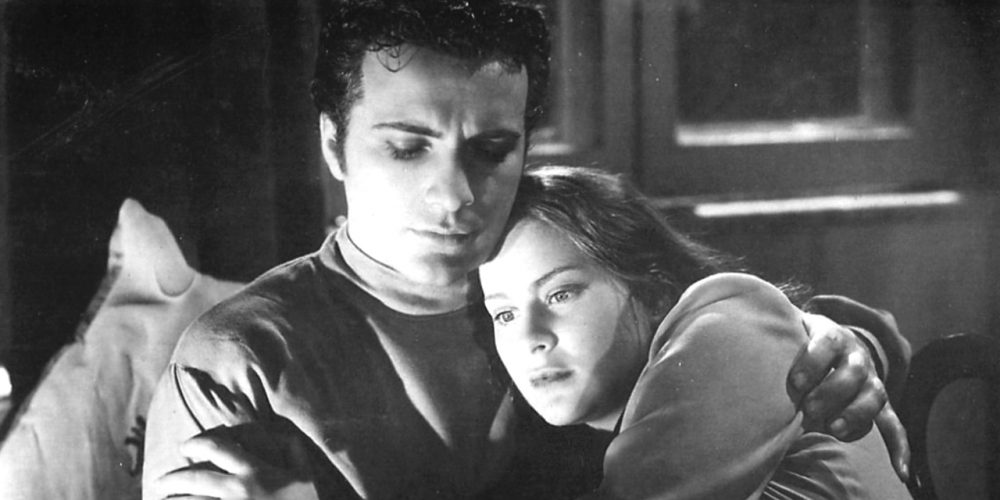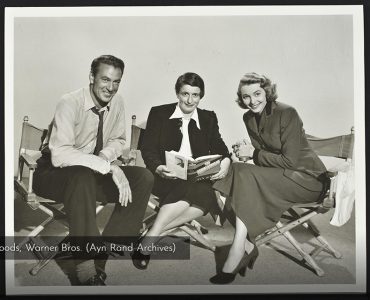“The cast, direction and production are excellent,” said Ayn Rand upon first viewing the unauthorized, two-film Italian adaptation of her first published novel, We the Living. Eventually Rand decided to have the 1942 movies Noi Vivi and Addio, Kira edited for release in America.
A newly restored, high-definition version of the films — condensed into one movie incorporating Rand’s edits — will be screened for attendees at the 2022 Objectivist Summer Conference in Washington, DC, July 1–7. Prior to that pre-release sneak preview, producer Duncan Scott will discuss the making of the original films, the editing process as guided by Ayn Rand, his recent frame-by-frame restoration, and his plans for bringing We the Living back to Italy, where the films debuted eighty years ago. Though Rand never saw the final cut before her death in 1982, Scott notes that she had previously approved the film for release on condition that her requested modifications were included, and “I accomplished every change Rand had requested.”
On this occasion, we are pleased to feature an article by Peter Schwartz that provides a captivating account of the films’ astonishing history. This article, reprinted with the author’s generous permission, originally appeared in the August 17, 1988, issue of his newsletter, The Intellectual Activist. Schwartz, a former chairman of the board and current distinguished fellow at the Ayn Rand Institute, is the author of The Tyranny of Need: Examining the Code of Self-Sacrifice — and the Alternative of Rational, Non-Predatory Self-Interest. Individual back issues of The Intellectual Activist are available at the ARI eStore.
WE THE LIVING — The Movie
The Intellectual Activist
August 17, 1988
The movie’s history is almost as captivating as its content. The movie is a moral denunciation of the collectivist state — yet it was produced entirely under the auspices, and with the approval, of fascist Italy during World War II. The rights to the film were taken without the consent (or even knowledge) of the author, who would never have given the Italian government permission to make it — yet she was sufficiently pleased with the final product to work on its re-editing for release in the US. Mussolini’s concrete bound propagandists regarded the film as simply an attack on their wartime enemy Soviet Russia — yet it became a smash (albeit short-lived) hit when the public saw it as a condemnation of its own dictatorial government.
Now, some forty-five years after it was first produced, the restored film version of Ayn Rand’s We the Living, with English subtitles, may be just a few months away from its American theatrical premiere.
The movie’s intriguing past began in the early 1940s, when Italy’s noted director Goffredo Alessandrini, looking for a major drama to bring to the screen, chose to adapt We the Living. He was hoping that Ayn Rand’s powerful novel would allow him indirectly to castigate the Mussolini regime without arousing the censors’ anger. With the war on, negotiations to obtain the rights to the book were out of the question. But Mussolini had a crudely elemental policy regarding copyrights belonging to citizens of enemy countries: steal them.
Alessandrini commissioned two Italian authors to write the screenplay while he was away working on another movie. When he returned, he discovered that the two had completely botched the assignment. Their script was filled with jarringly bizarre elements, including the portrayal of Kira as a ballerina. It was unusable and unsalvageable. Since shooting was scheduled to begin immediately, Alessandrini, with the concurrence of the production studio, Scalera Films, made a bold decision. He would work without a script. The associate director, Anton Majano, worked feverishly to sketch out the necessary scenes and dialogue the day before shooting, and early each morning his assistant came by to prepare copies (in pre-photocopier days) for the cast. It turned out that this unorthodox method, despite the obvious problems it caused, yielded one overwhelming benefit. It left little possibility for making changes and thus forced the film to mirror the novel (which rarely occurs in adaptations). The result was a product which Ayn Rand later said was far superior to what Hollywood would have allowed to be created.
At the time, the fascist government regulated political and artistic expression. Alessandrini saw We the Living as a vehicle by which to elude the state’s shackles and to present his true views. He hired two of Italy’s highest-paid stars — twenty-six-year-old Rossano Brazzi as Leo and twenty-one-year-old Alida Valli as Kira — and cast the country’s top box-office attraction, Fosco Giachetti, in the role of Andrei. Alessandrini wanted this to be a blockbuster film, one that would deeply touch the public by appealing to the broad disenchantment with the fascist state.
He succeeded. After four and a half months of grueling ten- to fourteen-hour work days — including the final pre-deadline period during which, according to Majano, “we worked straight through, five days and nights” — the movie was finished. Actually, it was two movies. Because of the write-as-you-go screenplay, Alessandrini and Majano eventually found themselves shooting far more film than they could conceivably use. But the material was too good to discard. So they came up with a novel solution of dividing the story into two separate movies: Noi Vivi (We the Living) and Addio, Kira (Farewell, Kira).
The worst problem was dealing with government censors. One morning during filming, an official of the Ministry of Culture appeared on the set. He demanded that a screening be held that very evening, at the Ministry headquarters, so that everything that had been shot thus far could be officially reviewed. Alessandrini and Majano spent the whole day in the editing room cutting out whatever seemed too antifascist. Two major scenes were eliminated: one, where Andrei makes his climactic speech repudiating the communist cause; the other, in which Leo is refused job after job because he lacks the necessary political background and connections. The edited version passed government inspection that night — after which the movie was promptly restored by the director to its original form.
But just hours before its scheduled premiere at the Venice Film Festival, a journalist who had seen the movie at a press screening complained to the authorities about the film’s political content. Again, the two troublesome scenes had to be removed. Still, the movie received a standing ovation from the audience, overwhelming praise from the (non-fascist) critics and the “Volpe Cup” award from the Festival.
When it was released publicly in November 1942 — with the two scenes back in — We the Living was an enormous success throughout Italy. Although the two halves were distributed several weeks apart, they ended up playing at the same time in many cities. People would typically see Noi Vivi at one theater, then rush across town to see Addio, Kira at another. They grasped the fact that their own oppressive government was as much a target of attack as was the Soviet Union’s. The people — in a wry, political takeoff on the two movies’ titles — began referring to themselves as “Noi Marti” (“We the Dead”) and to Mussolini’s economic policies as “Addio, Lira.” Rossano Brazzi, in an interview two years ago, recalled the public reaction. “Incredible,” he said. “It was a big hit.” Anton Majano, in a separate interview, expressed the same memories: “It was an extraordinary success, almost a fanatical success. . . . People would get up from their tables along the street and embrace me and say, ‘At last you’ve begun to go against the tide.’ People who saw it, who were intelligent enough, did realize what we were doing.”
Eventually, however, so did the government. Mussolini himself was reported to be furious over the film. Italy’s authorities “were amazed, some of them, how this picture got out,” Brazzi said. In addition, Nazi officials demanded that Italy suppress it. And so, five months after its release, the movie was banned and all the prints and negatives confiscated. In reaction, Brazzi and Valli decided to stop working in the movie industry until after the war. Scalera’s legal counsel was blacklisted by the government for having allowed We the Living to be produced. Alessandrini and Majano had to flee the country because of other anti-fascist activities of theirs. (Fittingly, when they crossed the Allied lines, what they used for identification were publicity pictures of themselves taken on the set of We the Living.)
When the war ended, with Scalera Films having gone out of business and with the literary rights to the film never having been obtained, the negatives were relegated by some holding company to an obscure vault outside of Rome. They would remain there, forgotten, for more than two decades.
In 1966, Ayn Rand mentioned the existence of the illicit film to her lawyer at the time, Henry Holzer. She had earlier met Rossano Brazzi, had been shown a print of the movie and had liked it. Holzer decided to search for the original negatives and eventually located and purchased them in Rome in 1968. In New York, Ayn Rand went over both halves of the movie, scene by scene (with someone reading from an English translation that had been provided with the negatives), orally editing it as a Moviola rolled. Duncan Scott, now a co-producer of the restored movie, was one of those present. He wrote down all her comments. “She was very perceptive, like someone who had been studying the movie for weeks before,” he recalls. “She displayed no hesitation. She would say to cut out this scene or to put these two together. Whatever made her a good editor of writing made her a good film editor, too.”
Although Ayn Rand basically liked it, there were numerous changes in the four-hour movie that she found necessary. Various scenes were eliminated, shortened, or moved. In the process of being translated into Italian and then retranslated back into English, the original language and intent of many scenes had been mangled. Consequently, all the dialogue had to be carefully re-subtitled to make it conform as much as possible to the novel.
The required alterations were both aesthetic and philosophical. In the artistic area, the changes included doing away with almost all of the subplots, which served to tighten the movie and to make it into a single, three-hour film. Probably the biggest transformation was the elimination of the final scene. Following the plot of the book, the movie had ended with Kira’s being shot as she tries to escape across the Soviet border. But here the scene was thoroughly ineffective. In the book, Kira’s thoughts are narrated. It is clear that, since the communist system had destroyed all her values, she is taking the only alternative open to her. It is clear why she chooses the near-certainty of physical death by fleeing over the absolute certainty of her spiritual death by staying. And, in this context, it is also clear that her tragic ending is a logical culmination of the anti-life policies of the collectivist state. In the movie, however, none of this is made intelligible. As Duncan Scott explains: “The ending was a brief, thirty-second scene. You quickly see Kira on a set with a phony-looking snowbank, and then she is abruptly shot. It is a false and senseless ending.” So the decision was made to take that out and to have the movie close with the immediately preceding scene, in which Kira stands in the garden where she first met Leo, hearing in her mind’s ear the words Leo had spoken to her in the beginning. The viewer infers that Kira, in response to the loss of Leo and to the memory of that which made Leo such a value to her, is resolved to escape, somehow. On that telling note, the movie ends.
The philosophical deficiencies were scattered throughout the dialogue. The translators had not been very fastidious. Nor had the directors been very astute intellectually. There were occasional lines intended to represent Ayn Rand’s philosophy that were instead implicitly altruist, or socialist, or anti-intellectual. (Some of the offensive lines had been gratuitously inserted to appease the fascist censors.) “The most horrendous philosophical mistake,” says Scott, “was Andrei’s inquisition scene, where he confronts and denounces his communist accusers. The Italian version had lengthy passages in which he says to them things like, ‘You sold out — you wanted the servitude of the Russian people to foreign capitalists.’ It was terrible.”
In fact, that particular scene was so bad that the initial decision was to kill it entirely. But the scene was so crucial to the theme that Scott proposed a drastic, but highly effective, alternative. He suggested retaining the scene, but replacing the existing Italian dialogue with a complete redubbing. This turned into a major project of its own since Scott needed to find actors who were competent both in the language of Italian and in the art of redubbing — whom he managed to locate only by traveling to Italy and having the work done there.
The massive re-editing began in 1968, but continued only intermittently until 1982. It was more than three-fourths done, when Ayn Rand’s death brought the project to a halt. But in 1985, with the cooperation of her heir, Leonard Peikoff, the work was resumed, and by 1986 the restored version of We the Living was completed.
All that remained was to find a company to distribute and market the film. It was exhibited in 1986 at the Telluride Film Festival in Colorado and at the Miami Film Festival in 1987, and drew largely favorable responses. At the Miami screening, in a 1,700-seat theater, it received a standing ovation at intermission. Reviewers said of the movie: “a beautifully crafted, entertaining work of art,” a “fascinating and precious chunk of film history” and “They don’t make ’em like this anymore . . . it’s a colossal love story within a massive philosophical framework.”
But dozens of prospective distributors approached by Duncan Scott turned the job down. Many said they personally liked the movie but did not believe there would be wide acceptance of such an old film done in black-and-white, or a film with subtitles, or a film that was three hours long, or a film without sex and violence. (Only one refusal was based explicitly on the fact that Ayn Rand’s name was involved.) Compounding the difficulty was Scott’s unwillingness to settle for the type of distributor that commonly handles restored movies. “We did not want the movie to be just slipped into a few revival houses here and there,” he says. “We wanted the same treatment, the same distribution and promotion efforts as a full-fledged foreign film.” Nor did Scott agree that the movie’s age represented a handicap. “This should attract moviegoers because of its background history — being banned in Italy, the good reviews it received, Ayn Rand’s name. Also, the movie should be very well remembered in the Italian-American community, almost like a lost Gone with the Wind. . . . If it was up to me, the advertising would boldly announce: ‘IN GLORIOUS BLACK-AND-WHITE.’ With the colorization controversy going on, movie-lovers would probably like the fact that a movie is proud that it is in black-and-white.”
Eventually, though, this problem too was overcome and a distributor was found who agreed with Scott’s basic marketing strategy. With that, the last major step in preparation for the American theatrical debut of We the Living was taken. When that debut occurs (now tentatively scheduled for year-end in New York City), what viewers will see is an exceptionally cast motion picture that follows the novel faithfully. Rossano Brazzi and Alida Valli are superb in their roles and Fosco Giachetti, despite being somewhat too old for the part of Andrei, nonetheless gives an excellent performance. The movie is done in an “old-fashioned” style — i.e., each event advances the plot, all the scenes are tied to the theme, and every line of dialogue actually means something. Although it lacks the philosophical elements of the book, the movie captures the brutally suffocating atmosphere of collectivism, and it unmistakably conveys the passion and the poignancy of this story about the moral struggle between the individual and the totalitarian state.
In wartime Italy, that message was urgently needed and the people avidly flocked to see it. Brazzi, who became involved in the Italian resistance movement, movingly recalled the film’s significance and emotional impact: “In Rome, people lined up for the picture for three months. There was a close-up picture of me and they made it into a small button, and the girls put it on their dresses. It had my picture as Leo and the words ‘NOI VIVI’ . . . I’ve done 250 pictures as a leading man, but I’ve saved prints of maybe three or four pictures for myself. And We the Living is one of those pictures. That was a good moment for Italy, for pictures. . . .”
But the anti-collectivist message of this movie is also desperately needed in America today. What type of cultural response, if any, it will engender here is uncertain. But the answer to that question will constitute the next chapter in this long and irrepressible history of We the Living — a chapter that may turn out to be no less fascinating than all its preceding ones.
Image courtesy Duncan Scott







